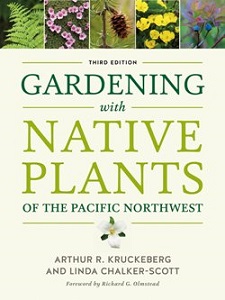 Art Kruckeberg (1920-2016) has a legendary reputation for his research and teaching in botany, and his expansion of that work into the natural history and geology of selected ecosystems. But for gardeners, he is best remembered for his classic “Gardening with Native Plants of the Pacific Northwest,” first published in 1982, followed by a second edition in 1996.
Art Kruckeberg (1920-2016) has a legendary reputation for his research and teaching in botany, and his expansion of that work into the natural history and geology of selected ecosystems. But for gardeners, he is best remembered for his classic “Gardening with Native Plants of the Pacific Northwest,” first published in 1982, followed by a second edition in 1996.
Linda Chalker-Scott is rapidly developing her own renown for books that encourage learning the science behind growing plants. Now she has taken on the major task of guiding the publication of a third edition of “Gardening with Native Plants of the Pacific Northwest.”
This is not just an editorial update. It is a collaboration from different perspectives and eras. Kruckeberg was a professor of botany for nearly four decades at the University of Washington until his retirement in 1989. In his first edition, he acknowledges the help of several individuals that figure prominently in the mid to later 20th century Arboretum, including Brian Mulligan, Roy Davidson, Joe Witt, C. Leo Hitchcock, Sylvia Duryee, and his wife, horticulturist Mareen Kruckeberg, the latter credited with conceiving the concept of this book.
Chalker-Scott is an associate professor of horticulture and extension specialist at Washington State University. Her contributions to the new edition further enhance the reader’s understanding of our native plants in their natural setting, and how to make them thrive in the not-very-natural setting of a typical home garden.
For those familiar with the older editions, the first thing you’ll notice in the new edition is the inclusion of many color photographs, almost one for every text entry. Each photograph has a selection of habitat icons “to help gardeners both visualize the best natural settings for native plants and identify environmental preferences.” For example, a plant may naturally grow in the full sun of a meadow or prairie, or it may need the superb drainage of a rock garden. Plants may be best adapted for wetlands or drylands, or perhaps a woodland or even a seashore. Another symbol marks plants especially successful in restoration projects. The new edition also updates taxonomy, reflecting the recent publication of the 2nd edition of the “Flora of the Pacific Northwest” (see my review in the Spring 2019 issue of “The Bulletin”).
For those new to this book, the breadth of the plant selection may be surprising – we have many garden-worthy natives. The emphasis is on woody plants. Almost all native trees are reviewed in some depth, including those not recommended for a garden setting. In the chapter on deciduous shrubs, ten “choice” species are considered first as the best choices. Much of the writing in these plant descriptions is the voice of Kruckeberg, although I noticed that favored plants are now “our” favorites – the two authors agree on most of the selections.
Chalker-Scott has added a new chapter that brings her signature work on horticultural science to the establishment and maintenance of a garden rich in native plants. She alleviates concerns about using “nativars” – propagated selections chosen for an unusual and desirable trait, such as double flowers or variegation. She also assures the new gardener that it is okay to mix well-behaved exotics into your garden of mostly natives.
One major difference between the second and third editions is the removal of any instructions on how to collect native plants from the wild. Chalker-Scott cautions, “This practice must stop if we are to retain many of our rare, threatened, and endangered species. It’s a better ethical and ecological choice to purchase native plants from reputable nurseries that have propagated and cultivated their plants without endangering native populations.”
Excerpted from the Summer 2019 Arboretum Bulletin